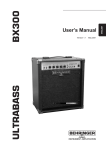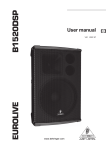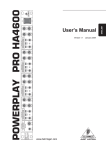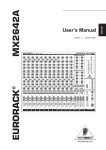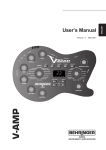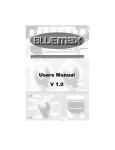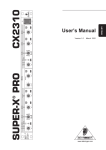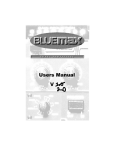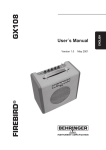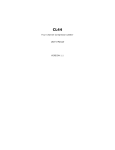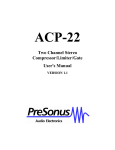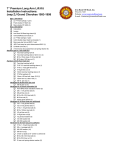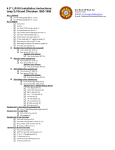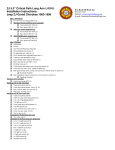Download ULTRA-VOICE VX2000 User`s Manual
Transcript
Version 1.1 December 2001 ULTRA-VOICE ® www.behringer.com ENGLISH VX2000 Users Manual ULTRA-VOICE VX2000 SAFETY INSTRUCTIONS CAUTION: To reduce the risk of electric shock, do not remove the cover (or back). No user serviceable parts inside; refer servicing to qualified personnel. WARNING: To reduce the risk of fire or electric shock, do not expose this appliance to rain or moisture. This symbol, wherever it appears, alerts you to the presence of uninsulated dangerous voltage inside the enclosure voltage that may be sufficient to constitute a risk of shock. This symbol, wherever it appears, alerts you to important operating and maintenance instructions in the accompanying literature. Read the manual. DETAILED SAFETY INSTRUCTIONS: All the safety and operation instructions should be read before the appliance is operated. Retain Instructions: The safety and operating instructions should be retained for future reference. Heed Warnings: All warnings on the appliance and in the operating instructions should be adhered to. Follow instructions: All operation and user instructions should be followed. Water and Moisture: The appliance should not be used near water (e.g. near a bathtub, washbowl, kitchen sink, laundry tub, in a wet basement, or near a swimming pool etc.). Ventilation: The appliance should be situated so that its location or position does not interfere with its proper ventilaton. For example, the appliance should not be situated on a bed, sofa rug, or similar surface that may block the ventilation openings: or placed in a built-in installation, such as a bookcase or cabinet that may impede the flow of air through the ventilation openings. Heat: The appliance should be situated away from heat sources such as radiators, heat registers, stoves, or other appliances (including amplifiers) that produce heat. Power Source: The appliance should be connected to a power supply only of the type described in the operating instructions or as marked on the appliance. Grounding or Polarization: Precautions should be taken so that the grounding or polarization means of an appliance is not defeated. Power-Cord Protection: Power supply cords should be routed so that they are not likely to be walked on or pinched by items placed upon or against them, paying particular attention to cords and plugs, convenience receptacles and the point where they exit from the appliance. Cleaning: The appliance should be cleaned only as recommended by the manufacturer. Non-use Periods: The power cord of the appliance should be unplugged from the outlet when left unused for a long period of time. Object and Liquid Entry: Care should be taken so that objects do not fall and liquids are not spilled into the enclosure through openings. Damage Requiring Service: The appliance should be serviced by qualified service personnel when: - the power supply cord or the plug has been damaged; or - objects have fallen, or liquid has been spilled into the appliance; or - the appliance has been exposed to rain; or - the appliance does not appear to operate normally or exhibits a marked change in performance; or - the appliance has been dropped, or the enclosure damaged. Servicing: The user should not attempt to service the appliance beyond that which is described in the operating instructions. All other servicing should be referred to qualified service personnel. 2 ULTRA-VOICE VX2000 FOREWORD Dear Customer, Welcome to the team of ULTRA-VOICE users, and thank you very much for expressing your confidence in BEHRINGER products by purchasing the VX2000. It is one of my most pleasant tasks to write this letter to you, because it is the culmination of many months of hard work delivered by our engineering team to reach a very ambitious goal: To present you with an outstanding product whose flexibility makes it an ideal tool both in studio and live sound environments. The task of designing our new ULTRA-VOICE certainly meant a great deal of responsibility, which we assumed by focusing on you, the discerning user and musician. It also meant a lot of work and night shifts to accomplish this goal. But it was fun, too. Developing a product usually brings a lot of people together, and what a great feeling it is when everybody who participated in such a project can be proud of what weve achieved. It is our philosophy to share our joy with you, because you are the most important member of the BEHRINGER family. With your highly competent suggestions for new products youve greatly contributed to shaping our company and making it successful. In return, we guarantee you uncompromising quality as well as excellent technical and audio properties at an extremely affordable price (manufactured under ISO9000 certified management system). All of this will enable you to fully unfold your creativity without being hampered by budget constraints. We are often asked how we manage to produce such high-grade devices at such unbelievably low prices. The answer is quite simple: its you, our customers! Many satisfied customers mean large sales volumes enabling us to get better conditions of purchase for components, etc. Isnt it only fair to pass this benefit back to you? Because we know that your success is our success, too! I would like to thank all people whose help on Project ULTRA-VOICE has made it all possible. Everybody has made very personal contributions, starting from the designers of the unit, to many staff members in our company to you, the user of BEHRINGER products. My friends, its been worth the trouble! Thank you very much, Uli Behringer 3 ULTRA-VOICE VX2000 ULTRA-VOICE ® High-performance mic preamplifier/voice processor s High-end vintage-design discrete transistor input stage VX2000 s Professional high-performance mic/line preamplifier and voice-processor s Authentic tube emulation circuitry for typical tube and tape saturation sounds s True RMS expander for extremely smooth noise reduction s Opto compressor for inaudible level control and creative sound processing s Integrated dynamic enhancer replaces high-frequencies lost through compression s Voice-optimized equalizer specially designed for voice enhancement s Opto de-esser for removal of excessive sibilance from your vocal track s High-performance VCAs for extremely natural sound processing s Ultra low-noise 4580 operational amplifiers for outstanding audio performance s Accurate LED metering for crystal-clear level and processor indication s Servo-balanced gold-plated XLR connectors for all main inputs and outputs s Ultra high-precision potentiometers for ultimate accuracy and repeatability s Illuminated switches ensure perfect operation in dark stage environments s High-quality components and exceptionally rugged construction for long life and durability s Shielded toroidal power transformer for lowest noise interference s Manufactured under ISO9000 certified management system 4 ULTRA-VOICE VX2000 TABLE OF CONTENTS 1. INTRODUCTION..................................................................................................................... 6 1.1 Before you begin ............................................................................................................................. 6 2. CONTROL ELEMENTS ......................................................................................................... 7 2.1 2.2 2.3 2.4 2.5 2.6 Discrete vintage input stage ............................................................................................................ 7 Expander and tube emulation .......................................................................................................... 8 Opto compressor ............................................................................................................................ 9 Voice-optimized EQ ...................................................................................................................... 10 Opto de-esser and master section ................................................................................................ 10 Rear panel ..................................................................................................................................... 11 3. RECORDING WITH THE ULTRA-VOICE ............................................................................ 12 4. MIXDOWN WITH THE ULTRA-VOICE ................................................................................. 13 5. THE ULTRA-VOICE IN LIVE APPLICATIONS...................................................................... 13 6. INTEGRATION INTO A RECORDING SYSTEM ................................................................. 14 7. AUDIO CONNECTIONS ....................................................................................................... 14 8. SPECIFICATIONS ................................................................................................................. 15 9. WARRANTY ........................................................................................................................... 16 5 ULTRA-VOICE VX2000 1. INTRODUCTION Thank you very much for expressing your confidence in BEHRINGER products by purchasing the ULTRA-VOICE VX2000. With the ULTRA-VOICE you now own a very useful device that allows you to creatively enhance your music. With its professional features, the VX2000 produces impressive results both in a studio environment and in live applications. Functions such as the opto compressor or the voice-optimized EQ enable you to process highly dynamic signals and adapt them to the overall sound of the music program. The BEHRINGER ULTRA-VOICE unites a microphone preamplifier, control amplifier and equalizer, and connects seamlessly to hard-disk recording systems, for example, to record vocals directly to disk. As a result, you get signals of the highest quality, as there is no insertion into a mixing console which deteriorates the audio. But also in live applications your ULTRA-VOICE offers pro-level signal processing functions to optimize vocal signals. In order to get to know the VX2000 and its functions, simply connect an audio signal and try each single control. Uncompressed signals, e.g. your own recordings, work best to get an idea of the opto compressor and how it works. Professional CDs usually contain pre-compressed material, so that sound changes through an additional compression stage cannot be perceived as easily. Once youve developed a feeling for the individual components of your VX2000, you can start combining the various functions to freely unfold your creativity. + This manual first describes the terminology used, so that you can fully understand the VX2000 and its functions. Please read the manual carefully and keep it for future reference. 1.1 Before you begin Your ULTRA-VOICE was carefully packed in the factory and the packaging is designed to protect the unit from rough handling. Nevertheless, we recommend that you carefully examine the packaging and its contents for any signs of physical damage, which may have occurred during transit. + If the unit is damaged, please do not return it to BEHRINGER, but notify your dealer and the shipping company immediately, otherwise claims for damage or replacement may not be granted. Shipping claims must be made by the consignee. Be sure that there is enough air space around the unit for cooling and please do not place the ULTRA-VOICE on high-temperature devices such as power amps or radiators, etc. to avoid overheating. Please use the enclosed power cord to connect the unit to the mains. The cord complies with all applicable safety standards. + Please note that all units must be grounded properly. For your own safety, you should never remove any ground connectors from electrical devices or power cords or render them inoperative. Before you connect the ULTRA-VOICE to the mains, please make sure that your local voltage matches the voltage required by the unit! The fuse holder on the female mains connector has 3 triangular markers, with two of these triangles opposing each other. The VX2000 is set to the operating voltage printed next to these markers and can be set to another voltage by turning the fuse holder by 180°. CAUTION: This instruction does not apply to export models exclusively designed, e.g. for 115-V operation! 6 1. INTRODUCTION ULTRA-VOICE VX2000 2. CONTROL ELEMENTS 2.1 Discrete vintage input stage Fig. 2.1: Discrete vintage input stage This section of your ULTRA-VOICE contains a preamplifier that allows you to determine the input level of mic or line signals. 1 Use the LINE switch to select the type of input signal used (in = LINE; out = MIC). 2 Press the +48V switch to provide condenser microphones with the necessary phantom power supply voltage. Dynamic microphones need no additional supply voltage. 3 The GAIN control adjusts the input level. The scale ranging from -12 to +12 dB refers to the LINE input, the 10 through 60 dB scale to the MIC input. 4 The SIG LED above the GAIN control lights up as soon as a signal is present at the input. 5 Make sure that the CLIP LED lights up only occasionally during loud passages. If it lights permanently or you can hear audible distortion, you should reduce the input level with the GAIN control. 6 The ULTRA-VOICE has a low-cut filter that eliminates low-frequency interference from your microphone signals. Use the LO CUT switch to activate this function. The filter has a slope of 12 dB/oct. 7 With the FREQUENCY control you can determine the frequency below which interference signals are suppressed (15 Hz through 360 Hz). 8 The Ø INV switch inverts the signal phase by 180°. Use this function in a multi-microphone set-up if you detect phase cancellations in specific frequency bands. 2. CONTROL ELEMENTS 7 ULTRA-VOICE VX2000 2.2 Expander and tube emulation Fig. 2.2: Expander and tube emulation The expander reduces the signal level during soft passages, so as to eliminate interference such as tape hiss or crosstalk. 9 Use the IN/OUT switch to activate or bypass the expander in the signal path. 10 The THRESHOLD control adjusts the level above which the expander comes in. 11 The DEPTH control determines the degree of signal reduction. The higher this value, the more signal reduction is applied. 12 Press the GATE switch to make the expander work like a noise gate, which not only reduces the signal level during soft passages but cuts it completely. The gate function should therefore be applied to single signals only, so as to avoid affecting the entire recording. 13 The four GAIN REDUCTION LEDs signal the degree of level reduction applied from -5 through -30 dB. The tube emulation function allows you to add a subtle distortion or tape saturation effect to vocals. Known from analog tape recorders and tube amplifiers this effect adds some upper harmonics to the signal and hence enhances it in the treble range. 14 Use the IN/OUT switch to enable/disable the tube emulation function. 15 The DRIVE control governs the intensity of the saturation effect. The more you turn it to the right (HOT), the more pronounced the effect will be. The portion of upper harmonics produced also depends on the input level adjusted in the discrete vintage input stage. 16 The SIG LED lights up when the tube emulation function has been switched on. 17 To avoid internal distortion, the CLIP LED should never light up all the time, but only briefly during very loud passages. 18 The TUNING control determines the frequency range to be processed with the saturation function. As all other ranges remain unaffected, you can apply this effect to specific frequency ranges. 19 Press the FULL BW switch to process the entire frequency spectrum. In this case, the TUNING control is inoperative. 8 2. CONTROL ELEMENTS ULTRA-VOICE VX2000 2.3 Opto compressor Fig. 2.3: Opto compressor The opto compressor reduces the dynamics of the input signal, i.e. the difference between soft and loud passages becomes smaller. Level peaks exceeding a specific threshold will be cut back to smooth out the overall sound image. 20 The IN/OUT switch activates the compressor. Use this switch to make a direct A/B comparison between compressed and uncompressed signals. 21 The THRESHOLD control determines the input level above which the opto compressor starts processing the input signal. Only if the adjusted threshold is exceeded will the compressor be activated. The dynamics of soft passages below that level remain unprocessed. The lower the threshold you choose, the more compression will be applied. 22 The HARD RATIO switch sets the signal reduction to maximum, producing a highly compressed sound whose dynamics are completely leveled out. Dont use this function if you want to preserve the natural dynamics of the input signal. 23 Press the FAST switch if you want the opto compressor to react quickly, once the threshold has been surpassed. In this case, the overall signal will be considerably more compressed, producing a very powerful sound. 24 Use the RELEASE control to adjust the compressor release time, which is the time that starts when the signal has fallen back below the threshold. The longer the release time, the more compressedand balancedthe sound image will be. 25 The OUTPUT control governs the output level of the compressed signal. As compression reduces the signal level, you can use this control to make up for the level reduction. 26 Compression may suppress specific frequency ranges. The built-in enhancer allows you to make up for this and round out the sound image by giving it new brilliance. 27 The six GAIN REDUCTION LEDs display the degree of compression ranging from -3 through -24 dB. 2. CONTROL ELEMENTS 9 ULTRA-VOICE VX2000 2.4 Voice-optimized EQ Fig. 2.4: Voice-optimized EQ The Voice-Optimized EQ is a 3-band equalizer for creative sound shaping. You can raise or lower the level of specific frequency ranges to make up for tonal deficiencies of the input signal. 28 Use the IN/OUT switch to activate the voice-optimized EQ. 29 The TUNING control selects a specific frequency range (130 Hz through 720 Hz). 30 The WARMTH control allows you to raise or lower the level of the frequency range selected. In level reduction mode the bandwidth is narrower than in level boost mode, i.e. you can adapt the filter setting specifically to the application concerned. 31 Use the PRESENCE control to give the signal more high and upper midrange brilliance (around 1700 Hz), so as to bring vocals more to the front and give them more presence in the overall sound image. 32 The BREATH control allows you to raise or lower the treble range, for example, to boost or cut vocal-specific frequencies (e.g. breathing noise). The frequency range processed is around 8 kHz. 33 The ABSENCE switch lowers those frequencies around 4 kHz that are responsible for a harsh and nasty sound. 2.5 Opto de-esser and master section Fig. 2.5: Opto de-esser and master section 10 2. CONTROL ELEMENTS ULTRA-VOICE VX2000 Vocal tracks are often affected by unwanted sibilant sounds. The opto de-esser allows you to easily remove interference of that kind. 34 Press the IN/OUT switch to activate the opto de-esser. 35 The THRESHOLD control determines the amount of suppression applied to sibilant sounds. The lower this value, the more sibilance is removed. 36 Use the CUT FREQ control to select the frequency range to be removed from the overall sound image. 37 The ACTIVE LED shows you that the opto de-esser is on. The more processing is applied to the signal, the brighter the LED lights up. + 38 + When using the opto de-esser, dont choose too low a threshold, so as to avoid affecting the original sound character of the program material. You have found the best setting for this parameter, when the difference to the unprocessed signal can be heard only by way of a direct A/B comparison with the IN/OUT switch. The MASTER FADER adapts the output signal to meet the input sensitivity of downstream devices (e.g. DAT or hard-disk recorder). When you adjust the signal levels, you should start with the lowest level possible and raise it slowly until the levels have been adapted properly. If you start with too high a level, you risk damaging the input stages of downstream devices! 39 The six OUTPUT LEVEL LEDs read the output level from -10 through +15 dB. 40 Use the POWER switch to switch the ULTRA-VOICE on and off. 2.6 Rear panel Fig. 2.6: Rear panel connectors of the ULTRA-VOICE 41 This is the balanced XLR connector for microphones (MIC) or LINE-level signals. 42 The LINE input is on a balanced 1/4" TRS jack. 43 This is the INSERT section on two 1/4" mono jacks that provides the SEND and RETURN to other effects devices. The signal is taken post-LO CUT-filter (input stage). 44 The XLR RECORDING output is for DAT/hard-disk recorders, etc. and is taken pre-opto de-esser. 45 These are the MAIN outputs of the ULTRA-VOICE, which are on balanced XLR and 1/4" TRS jacks. 46 Use the enclosed power cord to connect the unit to the mains. 47 SERIAL NUMBER. Please take the time to fill out and return the warranty card within 14 days from the date of purchase, so as to be entitled to benefit from our extended warranty. Or use our online registration option available on the Internet at www.behringer.com. 2. CONTROL ELEMENTS 11 ULTRA-VOICE VX2000 48 FUSE HOLDER / VOLTAGE SELECTOR. Please make sure that your local voltage matches the voltage indicated on the unit, before you attempt to connect and operate the VX2000. Blown fuses may only be replaced by fuses of the same type and rating. Some models allow for inserting the fuse holder in two different positions, in order to switch over from 230-V to 115-V operation, and vice versa. Please note that for 115-V operation outside Europe, you need to use a fuse of a higher rating (see chapter 1.1 Before you begin). 3. RECORDING WITH THE ULTRA-VOICE When youre recording with the ULTRA-VOICE you should try to achieve a natural sound image of high quality in the first place. Any special sound of the program material can be realized later on during the mixdown, without affecting the recorded signals. 1) Use the GAIN control of the discrete vintage input stage to set a gain level that suits the input material. 2) Be sure to take all measures that enable you to achieve the best sound possible: Check the microphone for its optimum position and the room acoustics for compliance with the sound you wish to achieve. Start by disabling all components of the ULTRA-VOICE in order to optimize the dry, i.e. unprocessed signal. 3) If required, use the opto compressor to smooth out the overall signal dynamics. Avoid overcompressing the signal, you can compress it again after recording. Dont use the hard ratio function in the first place, because it affects your signal audibly. If the singer doesnt keep a steady distance between mouth and microphone, the vocals may suffer from considerably varying dynamics. In this case, you should choose a higher compression setting. Set a relatively low threshold level on the opto compressor to ensure a constant loudness level. + Make sure that singers keep a steady distance between mouth and microphone, so as to avoid the need for excessive compression. When youre recording backing vocals, the signals should be compressed heavily to produce a steady loudness level during the entire recording. 4) Use the voice-optimized EQ to make up for deficiencies in the sound image, which cannot be eliminated before. Dont use extreme settings, you can still add some equalization during the mixdown. The voice-optimized EQ can be used to solve the following problems: s If a vocal track lacks transparency in the bass range, you can use the WARMTH control to fade out low-frequency signals. Set the control to full reduction, then use the TUNING control to identify the disturbing frequency range, until the vocals are more balanced in sound. Start by soloing the track, then check it together with the remaining signals. Adjust the WARMTH control until the overall sound is perfect. s If the vocals are too harsh, use the ABSENCE switch of the voice-optimized EQ to attenuate the frequencies that are responsible for the harsh sound. Additionally, you can turn up the WARMTH control a bit or use the BREATH or PRESENCE controls to filter the signals high-frequency range. s If the vocals are drowned out in the overall mix, increase their PRESENCE to bring them more to the front. s If the overall signal lacks brilliance, you can enhance the treble range with the PRESENCE or BREATH controls. Or use the opto compressors enhancer function to add some upper harmonics. 5) If the vocal tracks contain unwanted frequencies, you can use the expander and opto de-esser to remove them. The opto-de-esser also eliminates disturbing sibilance. First, you need to identify the frequency range containing unwanted signals: s Activate the voice-optimized EQ and turn up the BREATH control to raise the sibilant frequency range. If you have already used the EQ, remember the original setting to be able to reproduce it later on. s Activate the opto de-esser; adjust a low threshold then turn the CUT FREQ control until the sibilant sounds are audibly lowered in level. 12 3. RECORDING WITH THE ULTRA-VOICE ULTRA-VOICE VX2000 s Now you can disable the voice-optimized EQ and/or set the BREATH control back to its original position. s Adjust the threshold so that the ACTIVE LED lights up with sibilant sounds only. The expander allows you to remove disturbing signals in low-volume passages. Set the THRESHOLD control fully counterclockwise, choose a medium DEPTH rate, then turn the THRESHOLD slowly to the right, until soft passages are audibly reduced in level, without affecting the quality of vocal tracks. While recording, the gate function should only be used in extreme cases, for example, to produce a special effect. The gate is quite effective on the overall sound image and could ruin your recording. 6) Use the tube emulation function to give your recording the sound of a classic analog tape recorder. 7) Finally, the MASTER FADER allows you to control the output volume of your ULTRA-VOICE. 4. MIXDOWN WITH THE ULTRA-VOICE Feel free to use the ULTRA-VOICE and its functions during the mixdown. Often, extreme effect and filter settings are needed to make a specific signal fit into the overall sound. Vocals featuring high presence and a full sound in the mix have usually been tweaked heavily before. Normally, vocal tracks are enhanced with reverb during the mixdown. If the reverb signal contains unwanted noise (e.g. sibilance), you can use the opto de-esser to remove such interference signals. Do as described below: s Remove sibilance from vocal tracks as described above, then use one of the main outputs (not the INSERT path, which is pre-de-esser!) to drive the reverb unit. Be sure to set the direct level on the reverb unit to zero to process the wet signal only. s Now, add the resulting reverb signal to the consoles output signal taken from the RECORDING output of your VX2000. This signal is pre-de-esser. In this way, unwanted signals are removed from the reverb signal only, but not from the wanted signal. You can use the expander to eliminate interference from other instruments recorded e.g. via the headphones of the singer. Please note that any compression applied to this signal would be counterproductive, because it would limit the signal during loud passages and hence raise the unwanted interference in level. Although the ULTRA-VOICE has been primarily designed for vocal recordings, you can also use it to record and mix down any other signals. 5. THE ULTRA-VOICE IN LIVE APPLICATIONS As in the studio, the ULTRA-VOICE will be your useful sound shaper and problem solver for live applications as well. On small stages, the short distances between microphone and monitor speaker can cause feedback. In this case, you should try the VX2000s opto de-esser: s Set the THRESHOLD control to a relatively low value. s Use the CUT FREQ control to identify the frequency range that causes the feedback. s Now, turn up the THRESHOLD until the vocals are least affected and feedback is suppressed effectively. With high volume levels on stage, theres a lot of crosstalk, i.e. the microphones pick up not only the wanted signals (e.g. vocals), but also other signal sources around them. This can be much of a problem, because you can no longer process the single signals independently of each. Use the expander to isolate single signals and remove crosstalk, which is lowered in volume, while the louder wanted signal remains unaffected. For this application the gate function proves quite handy to remove unwanted signals completely. However, be sure to keep the wanted signal unaffected, when the gate cuts off the signals once they have dropped below the 5. THE ULTRA-VOICE IN LIVE APPLICATIONS 13 ULTRA-VOICE VX2000 threshold. Thus, soft passages could be cut off, even though they are supposed to fade out smoothly. The gate can also be used to process pulse-type sounds (e.g. snare drum, kick drum, tom-toms, etc.), as these signals have relatively short attack and release times. 6. INTEGRATION INTO A RECORDING SYSTEM As mentioned above, your ULTRA-VOICE is equipped for direct connection to recording media such as DAT recorders, analog tape recorders or digital hard-disk-based computer systems. You dont need to use a mixing console and can hence benefit from a much clearer signal, because potential interference signals produced by the console circuitry are excluded right from the start. If you wish to integrate your VX2000 into a hard-disk recording system, you will need an analog-to-digital converter which converts the analog signal from the microphone preamplifier into digital. Naturally, you can also use a conventional mixing console to integrate the ULTRA-VOICE into your studio environment. Like any other preamplifier, it connects to the balanced microphone or line inputs on the console and with its wealth of functions it is a perfect tool for a great variety of applications. 7. AUDIO CONNECTIONS Fig. 7.1: Various plug types 14 7. AUDIO CONNECTIONS ULTRA-VOICE VX2000 As a standard, the BEHRINGER ULTRA-VOICE VX2000 is equipped with electronically servo-balanced inputs and outputsexcept for the insert connectors. The circuit design features automatic hum and noise reduction for balanced signals and thus allows for trouble-free operation, even at the highest operating levels. Externally induced mains hum, etc. will be effectively suppressed. The automatic servo-function recognizes the presence of unbalanced connectors and adjusts the nominal level internally to avoid level differences between the input and output signals (6-dB correction). + Please ensure that only qualified persons install and operate the VX2000. During installation and operation the user must have sufficient electrical contact to earth. Electrostatic charges might affect the operation of the unit. 8. SPECIFICATIONS FREQUENCY RESPONSE Line In to Main Out (bypass mode) DISTORTION MIC -> Ins Send Line -> Ins Send < 0.02% / -30 dBu in / 30 dB Gain < 0.002% / 0 dBu in / Unity NOISE (absolute) A-weighted Main Out bal. Recording Out -98 dBu -100.5 dBu INPUT LEVEL (max.) Mic In Line In +11.5 dBu +22 dBu OUTPUT LEVEL (max.) Main Out bal. Main Out unbal. Recording Out Insert Send +22 dBu +22 dBu +22 dBu +22 dBu POWER SUPPLY Mains voltage Power consumption Fuse Mains connector 10 Hz to 200 kHz; +0 / -1.6 dB U.S./Canada 120 V ~, 60 Hz U.K./Australia 240 V ~, 50 Hz Europe 230 V ~, 50 Hz General export model 100 - 120 V ~, 200 - 240 V ~, 50 - 60 Hz 20 W max. 100 - 120 V ~: T 630 mA H 200 - 240 V ~: T 315 mA H Standard IEC receptacle PHYSICAL (H x W x D) 1 ¾" (44.5 mm) x 19" (482.6 mm) x 8 ½" (217 mm) WEIGHT 3 kg SHIPPING WEIGHT 4.2 kg BEHRINGER is constantly striving to maintain the highest professional standards. As a result of these efforts, modifications may be made from time to time to existing products without prior notice. Specifications and appearance may differ from those listed or illustrated. 8. SPECIFICATIONS 15 ULTRA-VOICE VX2000 9. WARRANTY § 1 WARRANTY CARD/ONLINE REGISTRATION To be protected by the extended warranty, the buyer must complete and return the enclosed warranty card within 14 days of the date of purchase to BEHRINGER Spezielle Studiotechnik GmbH, in accordance with the conditions stipulated in § 3. Failure to return the card in due time (date as per postmark) will void any extended warranty claims. Based on the conditions herein, the buyer may also choose to use the online registration option via the Internet (www.behringer.com or www.behringer.de). § 2 WARRANTY 1. BEHRINGER (BEHRINGER Spezielle Studiotechnik GmbH including all BEHRINGER subsidiaries listed on the enclosed page, except BEHRINGER Japan) warrants the mechanical and electronic components of this product to be free of defects in material and workmanship for a period of one (1) year from the original date of purchase, in accordance with the warranty regulations described below. If the product shows any defects within the specified warranty period that are not due to normal wear and tear and/or improper handling by the user, BEHRINGER shall, at its sole discretion, either repair or replace the product. 2. If the warranty claim proves to be justified, the product will be returned to the user freight prepaid. 3. Warranty claims other than those indicated above are expressly excluded. § 3 RETURN AUTHORIZATION NUMBER 1. To obtain warranty service, the buyer (or his authorized dealer) must call BEHRINGER (see enclosed list) during normal business hours BEFORE returning the product. All inquiries must be accompanied by a description of the problem. BEHRINGER will then issue a return authorization number. 2. Subsequently, the product must be returned in its original shipping carton, together with the return authorization number to the address indicated by BEHRINGER. 3. Shipments without freight prepaid will not be accepted. § 4 WARRANTY REGULATIONS 1. Warranty services will be furnished only if the product is accompanied by a copy of the original retail dealers invoice. Any product deemed eligible for repair or replacement by BEHRINGER under the terms of this warranty will be repaired or replaced within 30 days of receipt of the product at BEHRINGER. 2. If the product needs to be modified or adapted in order to comply with applicable technical or safety standards on a national or local level, in any country which is not the country for which the product was originally developed and manufactured, this modification/adaptation shall not be considered a defect in materials or workmanship. The warranty does not cover any such modification/adaptation, irrespective of whether it was carried out properly or not. Under the terms of this warranty, BEHRINGER shall not be held responsible for any cost resulting from such a modification/adaptation. 3. Free inspections and maintenance/repair work are expressly excluded from this warranty, in particular, if caused by improper handling of the product by the user. This also applies to defects caused by normal wear and tear, in particular, of faders, potentiometers, keys/buttons and similar parts. 4. Damages/defects caused by the following conditions are not covered by this warranty: s misuse, neglect or failure to operate the unit in compliance with the instructions given in BEHRINGER user or service manuals. s connection or operation of the unit in any way that does not comply with the technical or safety regulations applicable in the country where the product is used. s damages/defects caused by force majeure or any other condition that is beyond the control of BEHRINGER. 5. Any repair or opening of the unit carried out by unauthorized personnel (user included) will void the warranty. 6. If an inspection of the product by BEHRINGER shows that the defect in question is not covered by the warranty, the inspection costs are payable by the customer. 7. Products which do not meet the terms of this warranty will be repaired exclusively at the buyers expense. BEHRINGER will inform the buyer of any such circumstance. If the buyer fails to submit a written repair order within 6 weeks after notification, BEHRINGER will return the unit C.O.D. with a separate invoice for freight and packing. Such costs will also be invoiced separately when the buyer has sent in a written repair order. § 5 WARRANTY TRANSFERABILITY This warranty is extended exclusively to the original buyer (customer of retail dealer) and is not transferable to anyone who may subsequently purchase this product. No other person (retail dealer, etc.) shall be entitled to give any warranty promise on behalf of BEHRINGER. § 6 CLAIM FOR DAMAGES Failure of BEHRINGER to provide proper warranty service shall not entitle the buyer to claim (consequential) damages. In no event shall the liability of BEHRINGER exceed the invoiced value of the product. § 7 OTHER WARRANTY RIGHTS AND NATIONAL LAW 1. This warranty does not exclude or limit the buyers statutory rights provided by national law, in particular, any such rights against the seller that arise from a legally effective purchase contract. 2. The warranty regulations mentioned herein are applicable unless they constitute an infringement of national warranty law. The information contained in this manual is subject to change without notice. No part of this manual may be reproduced or transmitted in any form or by any means, electronic or mechanical, including photocopying and recording of any kind, for any purpose, without the express written permission of BEHRINGER Spezielle Studiotechnik GmbH. BEHRINGER and ULTRA-VOICE are registered trademarks. ALL RIGHTS RESERVED. © 2001 BEHRINGER Spezielle Studiotechnik GmbH. BEHRINGER Spezielle Studiotechnik GmbH, Hanns-Martin-Schleyer-Str. 36-38, 47877 Willich-Münchheide II, Germany Tel. +49 (0) 21 54 / 92 06-0, Fax +49 (0) 21 54 / 92 06-30 16 9. WARRANTY

















